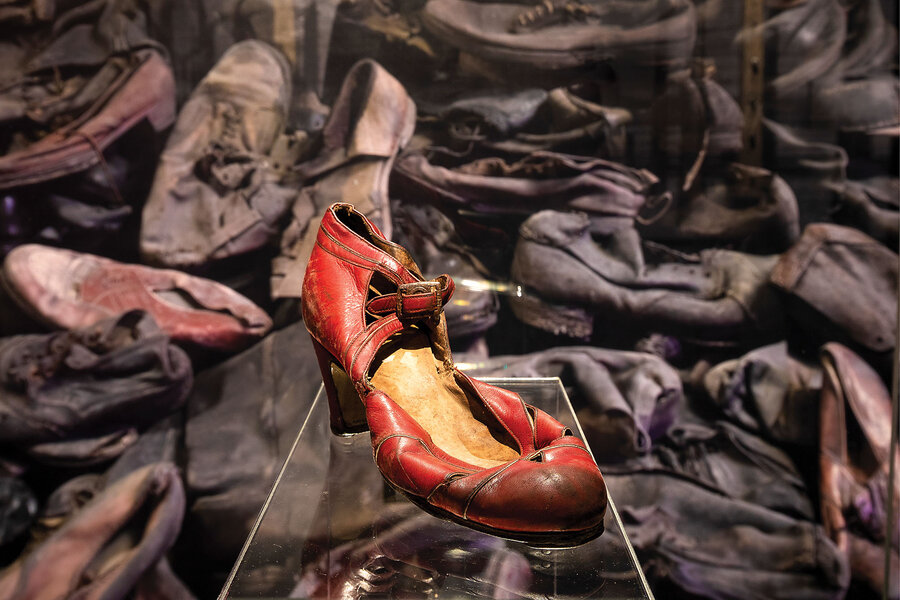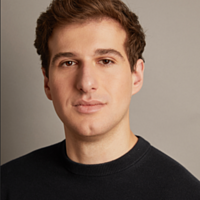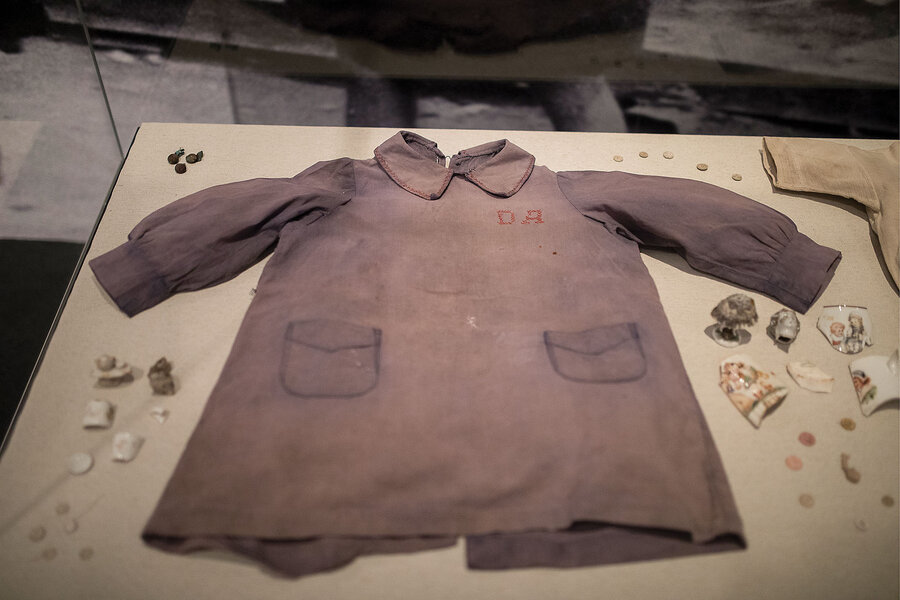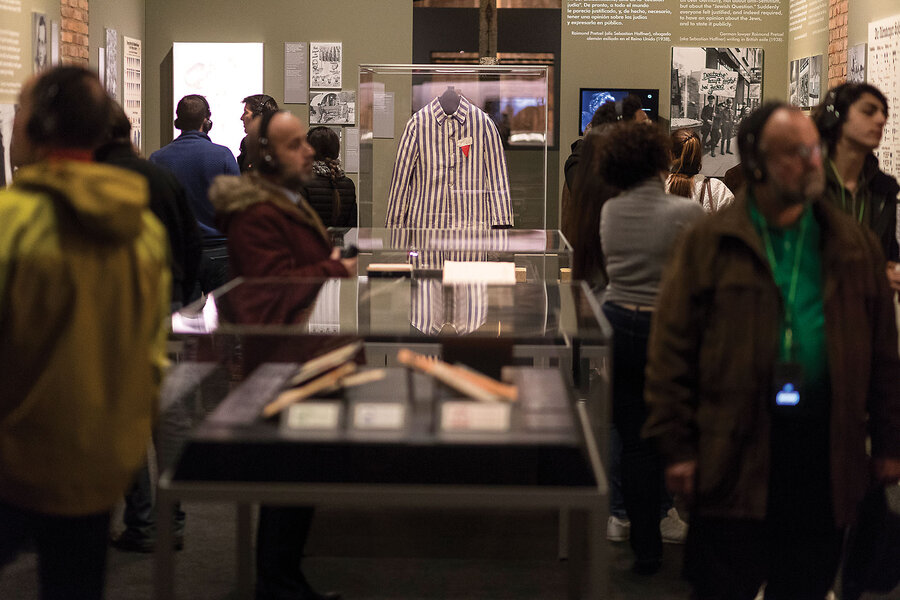With antisemitism on rise, Auschwitz exhibit counters with proof of Holocaust
Loading...
| Boston
In a glass case at “Auschwitz. Not Long Ago. Not Far Away.” lie many items people carry in their purses and totes: hairbrushes, razors, glasses, loose buttons, perfume bottles. They make it easy to see the people behind the statistics.
Organizers of the exhibit aim to address rising antisemitism and denial of the Holocaust, especially since the Oct. 7 attack in Israel. On a bench in a dimly lit gallery by his mother’s yellow star, Robert Jan van Pelt, the chief curator and a professor, makes his case for relying on evidence.
Why We Wrote This
A story focused onAmid the Israel-Hamas war, antisemitism and Holocaust denial have risen. An Auschwitz exhibit stands firmly for the truth by providing evidence of atrocities – and humanity.
“We basically tell our students, ‘You may have your own opinions, but you can’t have your own facts,’” says Dr. van Pelt. “We leave something to [visitors] to draw their own conclusions and narratives.”
The exhibit, currently in Boston, features some 700 artifacts from the Nazis’ largest concentration camp. On a recent visit, Nancy Harrowitz, director of Boston University’s Elie Wiesel Center for Jewish Studies, says there was a “somber hush in the air.”
“I do think that exhibits like this fight against Holocaust denial in an active and vivid way by presenting physical proof and testimonies,” she says.
In a crowded 1996 British courtroom, Robert Jan van Pelt was called on as a witness in a lawsuit to confirm this fact: Jews were systematically murdered at Auschwitz, over 1 million of them.
Historian Deborah Lipstadt had been sued for calling British academic David Irving a Holocaust denier in one of her books. So Mr. Irving sued for libel, doubling down on his denial. As a result of the testimony of Dr. van Pelt and others, Dr. Lipstadt prevailed – providing solid proof of Nazi war crimes at Auschwitz.
Decades later, Dr. van Pelt has a new task ahead of him: providing evidence of the Jewish genocide’s worst site in a traveling exhibit.
Why We Wrote This
A story focused onAmid the Israel-Hamas war, antisemitism and Holocaust denial have risen. An Auschwitz exhibit stands firmly for the truth by providing evidence of atrocities – and humanity.
He aims to address rising antisemitism and denial of the Holocaust, especially since the Oct. 7 attack in Israel. Jews in academic settings increasingly feel sidelined in discussions of their history. In Greater Boston, for example, two separate advocacy groups led by students are suing Harvard University and the Massachusetts Institute of Technology for failing to protect Jewish students from harassment both inside and outside the classroom.
Dr. van Pelt, the chief curator of “Auschwitz. Not Long Ago. Not Far Away.” and a professor in Canada at the University of Waterloo, spoke with the Monitor at the exhibition’s latest stop in Boston. On a bench in a dimly lit gallery by his mother’s yellow star, her Dutch state ID branding her a Jew, and the fake ID she used to flee, he made his case for relying on evidence.
“We basically tell our students, ‘You may have your own opinions, but you can’t have your own facts,’” says Dr. van Pelt before turning his gaze toward the striped pajamas, the yellow star, and a giant barrack lifted from Auschwitz. “We leave something to [visitors] to draw their own conclusions and narratives.”
The exhibit features some 700 artifacts from the Nazis’ largest concentration camp. Curators say they have tried to present material in a way that accommodates visitors of all ages and backgrounds. The Liberty Mutual Foundation has paid for 10,000 schoolchildren in the area to visit the exhibition, housed at The Saunders Castle at Park Plaza through the summer.
“There was a somber hush in the air. I did not hear any conversations except in whispers, no laughter or any indication that the visitors were anything but completely immersed in the experience,” Nancy Harrowitz, director of Boston University’s Elie Wiesel Center for Jewish Studies, says of her March 17 visit. “I do think that exhibits like this fight against Holocaust denial in an active and vivid way by presenting physical proof and testimonies.”
People behind the statistics
In a glass case lie the many items people carry in their purses and totes: hairbrushes, razors, pocketbooks, glasses, loose buttons, hand mirrors, compacts, and cologne and perfume bottles. They make it easy to see the people behind the statistics.
Isabella Nguyen, a young professional in media, and her millennial friend group stopped by after work to better understand a moment in history amid trending discussion of genocide and antisemitism.
“I’ve been [at the exhibit] for three hours with my friends. It’s a testament to how detailed” it is, Ms. Nguyen says. “They went into the history and political background of the climate and where it started. The situation was similar [to now].”
“Auschwitz didn’t happen in a vacuum”
Antisemitism emerged strongly during an economic downturn in Germany in the 1930s. A small plaque enlightens visitors that Germany’s currency, the deutsche mark, was informally referred to as “Jewish confetti” – a dig at the background of the finance minister who eventually did rein in hyperinflation.
“I think giving context not only to the Nazi ideology but also of the duration of [its] power is important,” says Paweł Sawicki, a spokesperson for the Auschwitz-Birkenau State Museum in Poland. “Auschwitz didn’t happen in a vacuum.”
In one gallery, Jewish rituals and talismans are explained, speaking to the rich cultural life that existed in pre-Holocaust Poland in the city of Oświęcim, or Auschwitz. Resting inside a glass case is a tallit – a thin religious cloth traditionally worn by Jews in prayer and during burial. The people who gained a reputation for their “odd customs,” one wall plaque states, stuck out in European society.
“Most exhibits do not have much focus on what Jewish life was like before the Nazi destruction,” says Dr. Harrowitz. “The inclusion of this material helped to humanize Jewish populations, encouraging empathy for the victims, rather than just understanding them as faceless numbers.”
How do you hold on to humanity in degrading conditions? Isabella Ribinstajn, a teenage Auschwitz prisoner, wore a pink slip under her uniform each day, preserving some sense of a normal girlhood. Its frayed cloth now sits under a dim light for other young girls to see.
“My students didn’t know the levels of resistance that people performed. These acts of resistance ... were new to them,” says Sarah Barbato, a history teacher who took her class from Souhegan High School in Amherst, New Hampshire.
Teachers are up against an influx of disinformation, says Ms. Barbato. “Denial is the final step of genocide,” which she makes sure to remind her students. She and a fellow educator, Aimee Gibbons, strive to steer their students toward the facts and away from digital propaganda.
On social media, an incubator of cultural pessimism, antisemitism will find a home in the hearts of those who are looking for a convenient scapegoat for global disorder, Dr. Harrowitz explains. “The retelling of the old and vicious antisemitic myths about Jews and power make young people more vulnerable to believing misinformation about the Holocaust,” says Dr. Harrowitz.
Rooms of context and glass cases of personal belongings build to a confrontation with the Nazis’ instrument of mass murder, cyanide-based pesticide. Canisters of Zyklon B look like charred cans of spray paint to the untrained eye. A gas mask beside them makes their purpose unmistakable. Here was the proof that held up as Dr. van Pelt took the stand against Holocaust denial.
By slowing down and sampling maybe four, five, or six artifacts in the exhibit, you get an impression of the horror, Dr. van Pelt remarks as he walks between galleries that are bounded by transported fence posts – rusted wire limp at their sides. “This idea that people are willing to immerse themselves in a difficult story is important – and [that they] are willing to give it some thought,” he says.
Editor’s note: This story has been updated to delete references to a 2023 Economist/YouGov survey about 20% of young Americans being Holocaust deniers. The survey’s opt-in methodology has been shown to be flawed.











